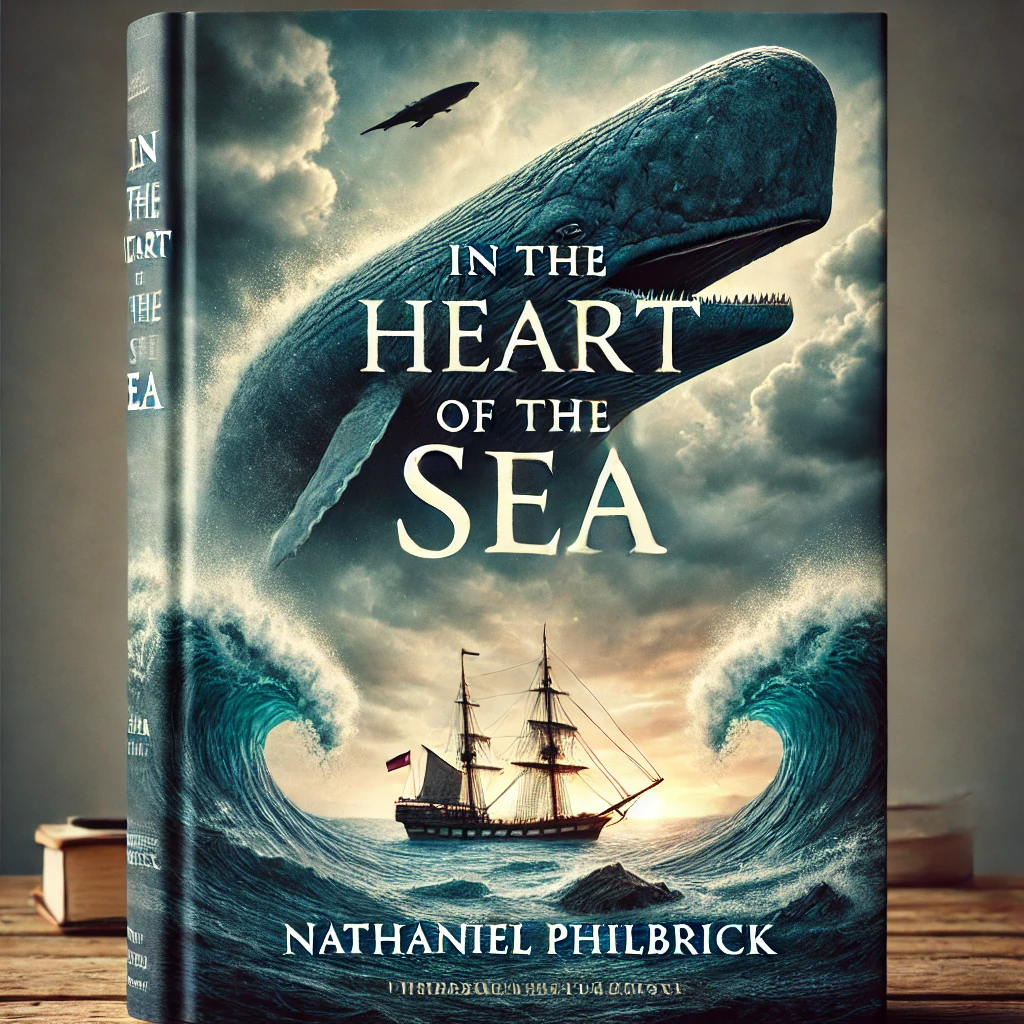Introduction to “In the Heart of the Sea”
Nathaniel Philbrick’s In the Heart of the Sea: The Tragedy of the Whaleship Essex is a compelling retelling of one of the most terrifying maritime catastrophes in history. This thoroughly researched book tells the disastrous tale of the Essex, a Nantucket whaleship, which lost its tragic battle in the Pacific Ocean in 1820. The catastrophe that occurred on the Essex inspired Herman Melville to write his legendary novel, Moby-Dick. Philbrick skillfully interweaves eyewitness accounts, historical background, and the human condition to recount this chilling story, set In the Heart of the Sea.
Setting the Stage: Nantucket and Whaling Culture
The novel opens on the crowded island of Nantucket, Massachusetts, the hub of the 19th-century whaling trade. Whaling was not just a job; it was the lifeblood of the island. Nantucket’s economy was based on the profitable whale oil business, which lit lamps and powered machinery all over the world. The Essex, a 238-ton whaleship, was commanded by George Pollard Jr. and manned by 20 men, including first mate Owen Chase and cabin boy Thomas Nickerson, who was barely out of his teens.
As the narrative unfolds In the Heart of the Sea, readers witness the extreme conditions faced by the crew of the Essex.
Philbrick’s detailed description of Nantucket provides a vivid picture of a society deeply tied to the sea. The author highlights the expertise and resilience of Nantucket’s whalers, who ventured into dangerous waters in pursuit of sperm whales, the primary source of valuable oil.
The Journey Starts: Hope and Perseverance
Their courage In the Heart of the Sea exemplifies the human spirit’s resilience against adversity.
This foreshadowing leads to the tragic events that unfold In the Heart of the Sea.
This journey, In the Heart of the Sea, marks a pivotal moment in the crew’s lives, filled with hope and perseverance.
This incident marks a horrific turning point, showcasing nature’s raw power In the Heart of the Sea.
Philbrick’s narrative unfolds, emphasizing the struggle for survival In the Heart of the Sea.
The Essex set sail from Nantucket in August 1819, embarking on what was expected to be a routine two-year whaling expedition. The crew was a mix of seasoned sailors and inexperienced young men, all eager to prove themselves. Their journey took them around Cape Horn and into the rich whaling grounds of the Pacific Ocean.
In the Heart of the Sea, the crew’s desperate fight reflects the human instinct to survive.
At first, the journey appeared promising. The crew managed to harpoon several whales, which provided them with more supplies of oil. Ominous signs started appearing, though. Rough seas damaged the Essex, which prompted the crew to perform repairs. These initial mishaps predicted the tragedies that awaited them.
The Attack of the Whale: A Turning Point
Facing starvation In the Heart of the Sea, the crew’s decisions highlight the moral dilemmas of survival.
The turning point of the Essex tragedy took place on November 20, 1820. As the crew pursued a group of sperm whales, a massive bull whale, estimated at 85 feet in length, struck the ship twice with incredible force. The hull of the ship was breached, and the Essex started to sink quickly. The crew’s sense of security was destroyed, leaving them stranded in the middle of the Pacific Ocean, thousands of miles from shore.
Philbrick’s account of this incident conveys the absolute horror and shock of the sailors. The whale’s attack is a mystery, with theories ranging from territorial protection to unintentional provocation. This point of devastation was the genesis of a desperate fight for survival.
The aftermath of their ordeal In the Heart of the Sea serves as a testimony to human resilience.
Even Captain Pollard’s return to Nantucket was a reminder of the events In the Heart of the Sea.
Philbrick’s reflection on the legacy of the Essex tragedy is deeply rooted In the Heart of the Sea.
In the Heart of the Sea, themes of survival and moral dilemmas resonate throughout the narrative.
This exploration of human endurance In the Heart of the Sea is a poignant reminder of our vulnerabilities.
Adrift at Sea: Survival Against the Odds
After Essex sank, crew members salvaged what they could – navigating equipment, food, and water. They split between three small whaleboats and braced themselves to cross the expanse of Pacific Ocean. Early thoughts were to head west to Marquesas Islands, but rumors of cannibalistic natives influenced them to decide on a more circuitous, danger-filled route to South America.
The journey was grueling. The men endured scorching heat, violent storms, and relentless hunger. Provisions dwindled quickly, forcing the crew to ration their supplies. As weeks turned into months, their physical and mental states deteriorated. Philbrick’s vivid descriptions of their suffering create a profound sense of empathy for these mariners.
The Descent into Cannibalism
Perhaps the most chilling part of the Essex tragedy was the cannibalism of the crew. When starvation began to take hold, the men were reduced to making horrific decisions. When one of their number died, his body was eaten to feed the others. In the end, the survivors turned to drawing lots to decide who would be sacrificed for the survival of the group.
Philbrick approaches this sensitive subject with delicacy, highlighting the psychological anguish and moral suffering that the crew had to endure. The testimony of Owen Chase and Thomas Nickerson is firsthand evidence of these dark choices, presenting a stark picture of human desperation.
Rescue and Aftermath
After 95 days in the ocean, the remaining crew members were rescued by ships that passed by. Of the 20 men who had set out on the journey, eight survived. The experience left them physically and psychologically traumatized, with some never recovering from the ordeal.
Captain George Pollard Jr., who had won the lottery to eat his cousin, was back on Nantucket in shame. He set sail on a second whaling trip, and his second vessel sank as well, solidifying his place as a jinxed sailor. Owen Chase chronicled his adventure in a memoir, which would later inspire Herman Melville’s Moby-Dick.
Philbrick’s epilogue delves into the legacy of the Essex tragedy, such as its influence on literature and popular culture. He ponders the strength of the human spirit and the moral challenges of those in life-and-death circumstances.
Themes and Lessons
Ultimately, In the Heart of the Sea, Philbrick crafts a narrative that is both engaging and thought-provoking.
In the Heart of the Sea explores a number of deep themes, such as:
Survival and Human Resilience: The resolve of the crew to survive against all odds demonstrates the extent of human resilience.
Man vs. Nature: The narrative highlights the volatility and force of nature, reminding us of the vulnerability of humanity.
Moral Dilemmas: The ethical dilemma confronting the crew, especially their turning to cannibalism, challenges readers to reflect upon the boundaries of morality under extreme situations.
The Fragility of Civilization: Philbrick looks at how easily norms within society can decay when survival is on the line.
Wider Historical Context
Philbrick places the Essex tragedy into the larger perspective of 19th-century whaling and maritime discovery. Whaling, during the period, was both an economic necessity and a cultural pillar in Nantucket. This line of work was, however, marred by danger, from erratic seas to wild animal behavior.
The story also intersects with the era’s growing awareness of the Pacific’s vastness and the challenges of global navigation. Sailors ventured into uncharted waters, driven by ambition and economic pressures, often facing dangers that tested the limits of their skill and endurance.
Legacy of the Essex Disaster
The Essex tragedy left an indelible mark on history and literature. Herman Melville’s Moby-Dick immortalized the event, transforming the whale into a symbol of nature’s awe-inspiring power. Beyond literature, the tale has inspired films, documentaries, and academic studies, cementing its place as a cautionary tale about humanity’s relationship with nature.
Furthermore, the Essex saga also reminds us of the pitfalls of hubris and the importance of humility when facing nature’s uncertainties. It reminds us of the toughness of the human spirit and of the ethical richness in surviving against the odds.
Conclusion
Nathaniel Philbrick’s In the Heart of the Sea is a page-turning history of one of the world’s most tragic sea disasters. Through exhaustive research and masterful storytelling, Philbrick recreates the terrifying ordeal of the Essex crew. The book is both a warning and an affirmation of the power of human resilience. For readers looking for an unforgettable tale of survival, bravery, and the lasting power of history, In the Heart of the Sea is a must-read.












